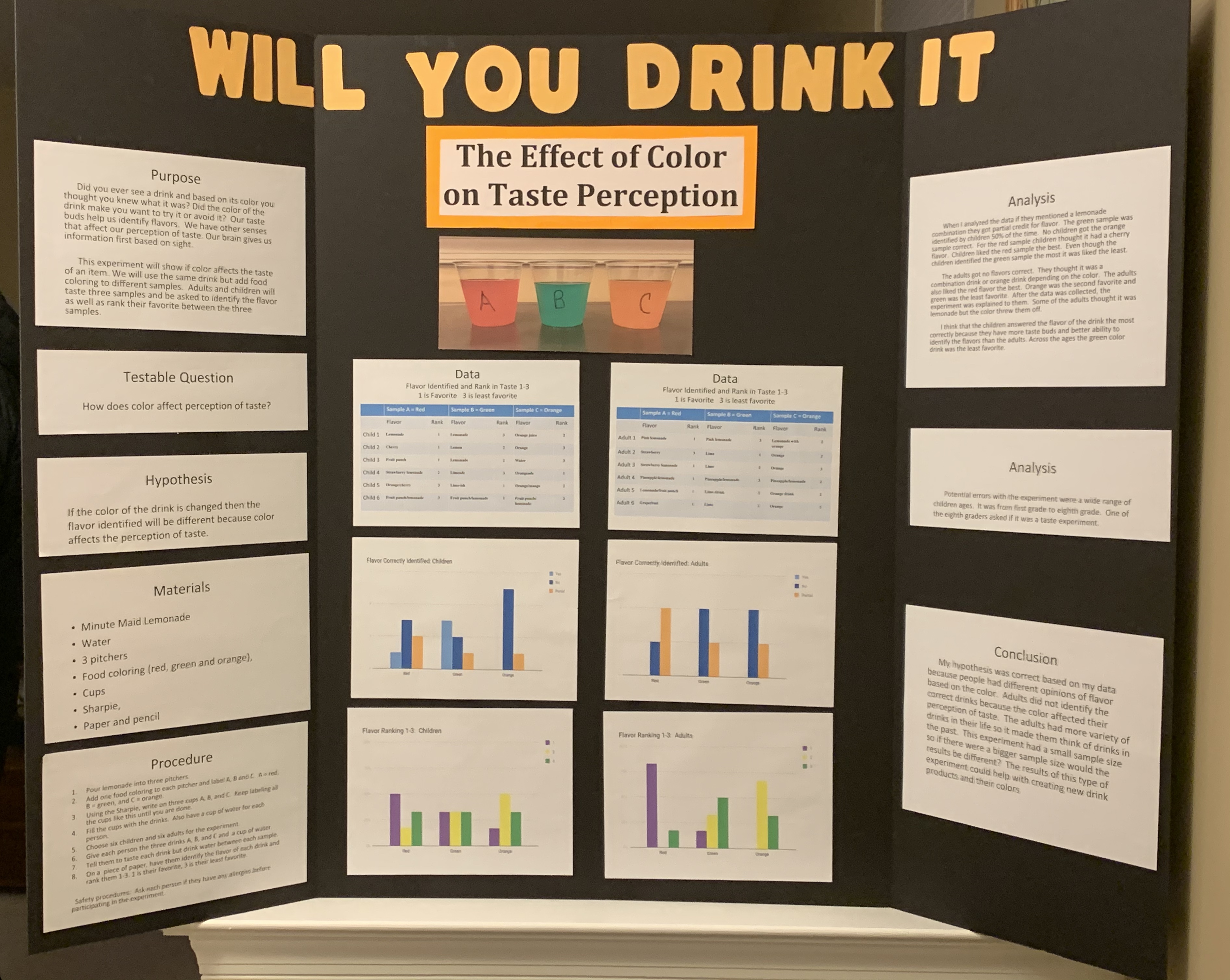The Effect of Color on Taste Perception
Abstract:
Did you ever see a drink and based on its color you thought you knew what it was? Did the color of the drink make you want to try it or avoid it?Our taste buds help us identify flavors.We have other senses that affect our perception of taste. Our brain gives us information first based on sight.This experimentshows if color affects the taste of an item. Weused the same drink but add food coloring to different samples.Adults and childrentasted three samples andasked to identify the flavor as well as rank their favorite between the three samples. Thehypothesis was that ifthe color of the drink is changed then the flavor identified will be different because color affects the perception of taste. When I analyzed the data if they mentioned a lemonade combination they got partial credit for flavor.The green sample was identified by children 50% of the time.No children got the orange sample correct.For the red sample children thought it had a cherry flavor.Children liked the red sample the best.Even though the children identified the green sample the most it was liked the least. The adults got no flavors correct.They thought it was a combination drink or orange drink depending on the color.The adults also liked the red flavor the best.Orange was the second favorite and green was the least favorite.After the data was collected it was revealed that all the drinks were lemonade. Some of the adults thought it was lemonade but the color threw them off. Potential errors with the experiment were a wide range of children ages.It was from first grade to eighth grade. Perhaps thechildren answered the flavor of the drink the most correctly because they have more taste budsand better ability to identify the flavors than the adults. Thehypothesis was correct based on thedata because people had different opinions of flavor based on the color.Adults did not identify the correct drinks because the color affected their perception of taste.The adults had more variety of drinks in their life so it made them think of drinks in the past.This experiment had a small sample size so if there were a bigger sample size would the results be different?The results of this type of experiment could help with creating new drink products and their colors.Bibliography/Citations:
No additional citationsAdditional Project Information
Research Plan:
Rationale: There are a lot of drinks in the market. They come in all variety of tastes as well as color. When purchasing a drink does one pick a drink based on the color or appearance? Does the color make us think what the flavor will be? Our taste buds help us identify flavors. We also have other senses that affect our perception of taste. Our brain gives us information first based on the sense of sight. Developers of new drinks find this important information because it can impact sales of a product.
Research Question: How does color affect perception of taste?
Hypothesis: If the color of the drink is changed then the flavor identified will be different because the color affects perception of taste.
Materials needed: Minute Maid Lemonade, water, 3 pitchers, food coloring (red, green, and orange), cups, Sharpie, paper(eval form for participants) and a pencil.
Participants: 6 children and 6 adults; random selection of participants chosen at school and the church community room. Children age range is 1st to 8th grade. A table set up in the community room and the school gym and participants chosen based on those who approached the table. As participants are chosen, the project explained to them and all questions answered. Minimal risk involved; asked if they have any allergies or diabetic and unable to drink sugar drinks. Participants also told they could stop at any time if they didn't want to complete the study.
PROCEDURE:
- Pour lemonade into three pitchers.
- Add one food coloring to each pitcher and label A, B and C. A = red, B= green, and C= orange.
- Using the Sharpie, write on three cups A, B, and C. Keep labeling all the cups like this until you are done.
- Fill the cups with the drinks. Also have a cup of water for each person.
- Choose six children and six adults for the experiment.
- Give each person the three drinks A, B, and C and a cup of water.
- Tell them to taste each drink but drink water between each sample.
- On a piece of paper, have them identify the flavor of each drink and rank them 1-3. 1 is their favorite, 3 is their least favorite.
Data analysis: After completing the experiment with the participants, data will be analyzed counting the number of current responses to drink identification as well as how the drinks were ranked.
Bibliography:
Arnett.M. & Finio. B. (2019, February 8). Does Color Affect Taste? Retrieved from https://www.sciencebuddies.org/science-fair-projects/project-ideas/FoodSci_p081/cooking-food-science/does-color-affect-taste

